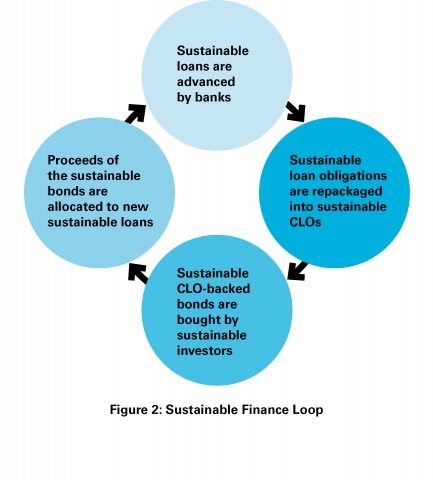
Governments and multilaterals alone cannot finance the transition to a sustainable, low-carbon economy: the world's savers (via the banks and bond market) represent the only pool of capital deep enough. The OECD estimates that $6.9tr of sustainable investment is needed by 2030 to meet the goals set out in the 2015 Paris Agreement. To date, the green bond market has not been inclusive enough to permit investment of the required scale: we need a more effective mechanism, the Sustainable CLO, to connect the bond market to sustainable debt around the world while simultaneously providing the banks with additional capital for sustainable projects.1
A recent development in the loan market looks set to provide a key building block to scaling up sustainable finance and provide flexible funding solutions to all types of borrowers. Hot on the heels of the first Green Loan Principles in 2018 and in light of the increasing popularity and borrower diversity in the green loan market (see Fig. 1), the first ever Sustainability-Linked Loan Principles2 ("SLLPs") have been published by the Loan Market Association ("LMA"), the New York-based Loan Syndicated and Trading Association ("LSTA") and the Asia Pacific Loan Market Association ("APLMA").
Figure 1: Global Green and ESG Loan Volume (Source: LMA)

What's new?
Sustainability-Linked Loans ("SLLs") will operate dynamically as both a 'carrot and a stick' with the interest rate of the SLL increasing (stick) or decreasing (carrot) to reflect changes to the sustainability rating of the borrower.
The publication of the SLLPs marks a change in approach compared to the 'use of proceeds' model which requires loan proceeds to be used for specific sustainable projects. Unlike conventional green 'use of proceeds' loans which solely revolve around the sustainable use of the loan monies, sustainability-linked loans are tied to the overall sustainability profile of the borrower, and provide a financial incentive (through decreasing costs of funds) as they improve their overall sustainability profile.
SLLs must feature the following:
- Relationship to borrower's overall corporate social responsibility strategy. Comparable to a company's Green/ Sustainable Framework in the context of a green use of proceeds loan or bond, the borrower should be able to link the proposed SLL to their overarching CSR/ ESG strategy.
- Target setting – measuring the sustainability of the borrower. This is the key substantive element of the SLLPs. For this tenet, the borrower sets the parameters through which the 'success' or 'failure' of the company to meet its sustainable goals, and the quantitative metrics determining whether the borrower will be rewarded or penalised through the loan's variable interest rate. Targets are set with reference to so-called Sustainability Performance Targets "SPTs". A none-exhaustive list of common SPTs is provided in Schedule 1 of the SLLPs, but these can be flexibly tailored according to the borrower's specific industry and circumstances.
- Reporting. The monitoring and reporting of data relating to the SLL borrower's sustainability is essential to the success of the SLL as a product, given that the accuracy and completeness of this data will have real and direct financial implications for the contracting parties. It will also be invaluable for allowing investors of SLL loan portfolios to verify the continuing sustainability credentials of their investment.
- Review. Verification of the sustainable credentials of labelled SLLs is arguably even more important in the context of sustainable loans as it is for bonds. In contrast to publicly traded bonds, loans are generally bilateral instruments which are less transparent and susceptible to 'green-washing' given that a key benefit for the lending bank is the reputation boost associated with being named as an SLL lender. Independent reviewers will ensure that the integrity of the SLL brand is maintained.
Why enter an SLL?
Financial and reputational incentives
SLLs provide both financial and sustainable benefits to loan counterparties. For borrowers, the SLLs provide a cheaper cost of capital for making a positive impact on the environment, in addition to the secondary incentives associated with becoming more sustainable, e.g. lower overheads due to increased energy efficiency. For lenders, SLLs present an opportunity to boost their reputation and demonstrate compliance with their commitments to increase sustainable lending, some of which runs into the hundreds of billions. Data has shown that sustainable loan assets have lower default rates than their conventional alternatives and a 'greenium' is beginning to materialise3. The most significant potential benefit of the emergence of SLLs is that they will provide the ideal collateral to be aggregated into sustainable CLOs ("SCLOs"), thereby connecting the bond market to the asset class4.
Regulatory future-proofing
The global regulatory environment5 appears to be heading towards increasing obligations relating to disclosure of environmental (and other ESG) impacts at the company level and showing adaptability to a 2-Degree Scenario6. Participating or investing in SLLs would provide an easy way of demonstrating support for transitions to a low-carbon economy, as well as greening investment portfolios to ensure readiness to take advantage of any regulatory incentives for holding sustainable assets. The reporting obligations for SLLs will provide a valuable segue for companies to begin making environmental disclosures, establishing best practices as well as their market position as a sustainable company before such disclosure obligations become mandatory.
Additionality
SLLs could address one of the most-cited criticisms of sustainable use of proceeds loans and bonds: lack of additionality. This is the concept that proceeds, while nominally allocated to sustainable purposes, are not making any additional progress towards preventing climate change, e.g. by refinancing existing green assets, or simply maintaining an existing level of sustainability for 'pure-play' companies and projects whose activities are all inherently sustainable. SLLs provide an active incentive for companies or institutions to improve – not just maintain - their sustainability profile wherever they currently sit on the sustainability spectrum. This means companies and institutions who are just beginning their transition away from an unsustainable business model or assets are not stigmatised, (as some have been in the green bond market), and are provided the necessary access to funding to start their transition to sustainability. SSLs can also incentivise pure-play companies and projects to find new ways to make a positive additional impact on the environment by taking advantage of the financial incentives SLLs offer.
Inclusivity for revolving credit facilities and SMEs
SLLs also widen the categories of loans, which can be considered sustainable. Until the SLLPs were published, the concept of a revolving credit facility was incongruous with the Green Loan Principles ("GLP"), since the use of proceeds could not easily be tracked into specific green projects in the way the GLP require. Borrowing under a revolving credit facility often makes the most commercial sense for small and medium sized companies in particular, who need loan monies for general corporate purposes and are not able to earmark funds for specific large-scale projects. The SLLPs do not require specific monies to be tracked – they only require the overall sustainability profile of the borrower to be measured using pre-agreed metrics and verification processes. The sustainability market is now open to a much broader range of potential participants and deal structures, which will may help provide funding to sectors or projects that have not been able to access to sustainable funding through green bonds and other sustainable finance methods.
Primed for SCLOs
For the bond market, the publication of the SLLPs is a welcome development as asset certification thereunder will provide valuable transparency that the associated loans meet internationally accepted standards of sustainability. As mentioned above, this means they can readily form the collateral for SCLOs. These structures are vital to the scaling up of the sustainable finance market by connecting deep pools of institutional investor capital in the bond market with sustainable investments at the micro level, while maintaining the economy of scale and transparency such investors require. Once the size of a lender's SLL portfolio has reached a critical mass, they can sell it to a CLO vehicle, clearing their balance sheet and making way for the next wave of SLLs to be extended, creating a Sustainable Finance Loop (see Fig. 2). The data reporting obligations associated with certified SLLs mean that investors in SLL-backed SCLOs will have ongoing comfort that the assets underlying their investments continue to meet minimum sustainability requirements.

SSLs can play a role in funding the huge pipeline of renewable projects
Many companies and institutions continue to make good progress toward sustainable growth and transition to low-carbon economies, setting new sustainability and resilient infrastructure targets that are creating demand for capital and new sustainable funding methods. SLLs can provide funding for new and ongoing investments in sustainable projects. The expected rise in global renewable energy capacity is not the only development that could turn to SLLs for a source of sustainable finance, almost equal amounts of sustainable funding is needed in both the infrastructure and the real estate sectors, making both energy and construction leaders in the market7. Companies and institutions in these sectors have started examining their sustainability performance or the sustainability and impact of their projects for environmental and climate risks and they see SSLs as a way to reduce these risks and obtain finance at the same time.
The key to scale?
The SLL market has lower entry barriers than the green bond market8 and is open to companies of all sizes from SMEs to multinationals. Some lenders already internally allocate sustainability ratings to their loan portfolios, and many more lenders could find that upon analysis of their existing portfolios, it may not prove onerous to re-categorise existing loans as SLLs, much like some market participants have done to great effect in the green bond market. Existing green bond issuers and organisations adhering to reporting recommendations9 for monitoring and reporting on sustainability will find that they already have full capacity to borrow or lend under SLL terms.
SLLs present opportunities for all market participants and look set to provide a prime supply of assets to feed into SCLOs, which are the key to supplying the gargantuan amount of sustainable finance required to achieve the goals mandated by the Paris Agreement. The SLLPs have unlocked a powerful new tool for seasoned sustainable financiers and newcomers to the market alike.
1 Global green bond issuance in 2018 was only $167.6bn
2 lma.eu.com/application/files/8015/5307/4231/LMA_Sustainability_Linked_Loan_Principles.pdf
3 https://www.moodys.com/research/Moodys-Project-finance-bank-loans-for-green-use-of-proceeds--PBC_1141935?showPdf=true
4 For further information about SCLOs please see the G20 white paper on SCLOs which was co-authored by White & Case: http://unepinquiry.org/wp-content/uploads/2018/12/Towards_a_sustainable_infrastructure_securitisation_market.pdf
5 See the Non-Financial Reporting Directive https://eur-lex.europa.eu/legal-content/EN/TXT/?uri=CELEX%3A32014L0095 and https://www.sec.gov/rules/interp/2010/33-9106.pdf
6 The 2-Degree Scenario or 2DS was a term popularised in the Paris Agreement of 2015, referring to a scenario in which we limit global increases in temperatures since pre-industrial times to 2 degrees centigrade. An increase in temperature of 2 degrees is the crux point beyond which the effects of climate change are said to become irreversible.
7 Overall, according to the Climate Bonds Initiative's January 2019 report, "Financing Low Carbon Buildings with Green Bonds," $126 billion had been allocated to low-carbon building assets and projects as of end-November 2018.
8 In terms of deal size and the extra regulation related to issuing securities.
9 Such as the non-financial reporting directive and the TCFDs: https://www.fsb-tcfd.org/publications/final-recommendations-report/
Alexander Buchanan (White & Case, Professional Support Legal Assistant, London) contributed to the development of this publication.
This publication is provided for your convenience and does not constitute legal advice. This publication is protected by copyright.
© 2019 White & Case LLP

